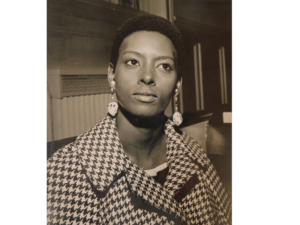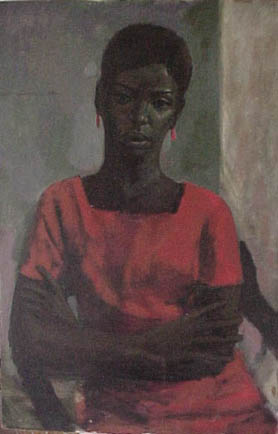Glanton Dowdell. Photograph from the Albert B. Cleage Jr. Papers, courtesy of Kristin Cleage.
In 1959, at sixteen, Rose Percita Brooks had two choices: the navy or the nunnery. The way her grandmother Rosie beat her for kissing a boy on a couch in her home made the girl want to run into a convent. At least there she would be far from the old woman’s wrath. Whatever inspired Rosie’s cruel beatings may have been a holdover from an ancestor’s pain during slavery times, some ghost haunting the old woman. Rosie was not yet born when slavery existed in Memphis, but she would always moan joyfully in church, as though she had witnessed the first Juneteenth. It was clear when the spirit possessed her. She grunted more loudly than anyone else. Oh, that’s Grandma, Rose thought. She’s happy now. She’s got the Holy Spirit.
It was Rose’s grandfather who told his wife that the girl was in the living room with a stranger. They had flirted from opposite ends of the sofa until Rose accepted the boy’s slow departing kiss. That same evening, Rosie surprised the girl when she was changing for bed. As she recoiled from her grandmother’s blows, Rose thought of herself as an abused housewife, so wholly bound to her captor that she started to feel indistinguishable from Rosie. Would she ever escape her grandmother’s orbit? Rose bathed the woman, laid out her church clothes, and had nearly the same damn name.
“What are you doing with that man?” Rosie demanded. The worst thing the girl could do was lift her arms to protect her face. Rosie’s force increased each time the girl tried to shield herself from the blows.
The old woman’s rage pushed Rose Percita away. Her dreams of Howard University and Tennessee State receded. In Nashville, the navy recruited Rose before the sisterhood could. She gave them her loyalty and hoped they would be gentler than the marine corps or air force. Boot camp and a nearly fatal swimming test were her first obstacles. She was posted at a naval station in Arlington, Virginia, as a stringer photographer for a navy paper. Over the next four years, few aspects of life on the base escaped her notice. She and her sole colleague, a white man from North Carolina, ran the publishing operation—“a cute little thing up on a hill,” Rose would later call it, a world of their own.
The delight of developing film and watching outlines take form on the photo paper kept Rose’s mind active.
Clubs for noncommissioned officers and enlisted men adjoined the photo lab. One captain, a surgeon at Walter Reed Army Medical Center, charmed Rose. He would not let the usual rites of courtship stand in his way, however, and so he tied her up and “took it.” It was her first time. Rose could not hide her “little watermelon” for long. Her honorable discharge in 1963 stranded her again, as a twenty-year-old. She was an expecting mother with no income and no roof. One of Rosie’s daughters, the girl’s aunt, lived in Detroit and agreed to take her in. The aunt was just as mean as Rosie. Rose forgave it but could not live with it, and she fled to the home of her uncle. She then met and married a kind man, naming her son after him: Bernard Waldon, Jr. They called the baby boy Barney.

Rose Waldon. Photograph from the Albert B. Cleage Jr. Papers, courtesy of Kristin Cleage.
***
By 1967, Rose Waldon had been in Detroit for a few years, but she still could not afford to buy herself a washing machine and dryer. She would often take her three-year-old son to the laundromat with her. A man approached them one day by the laundromat entrance as they were walking in. Was he some kook? What did he want? The man introduced himself as the assistant at an artist’s gallery. He made a claim that Rose would start to hear more often in the North: he told her that she had a memorable face.
It was true. Her jawline was sharp and her cheeks reflected varied gradations of light. Each of her dimples was a shallow depression. The assistant asked Rose if she would like to model for a mural of a Black Madonna and child at Reverend Albert Cleage Jr.’s Central United Church of Christ. She did not know what the church was or why this man would think a mother with her child at a laundromat would accept his invitation, but when he explained what the church was about—that it envisioned self-determination for black people everywhere—she said, “Why yes, I would be honored to try that.”
Rose and the artist Glanton Dowdell developed an easy rapport during the first interview at his studio, the Easel Gallery. He was quite handsome with that beard, those wide eyes, and the baby-faced pucker to his lips.
He asked her where she lived.
Not far from the gallery.
Had she done any modeling previously?
She had not.
Well, she might consider it.
Glanton had her sit in the back of the studio as he drew a portrait study in charcoal. The oils came later. Rose was asked to find a beautiful outfit. She had a designer weave a pretty caftan that made it appear as though she moved like water over rocks. Some of their evening sessions were brief, with not much accomplished, Rose thought. But on Glanton’s canvas, she took on a new form. Her face was looking like the sculpted clay busts of Modernist black artists—William Ellsworth Artis’s Head of an African American Woman (1939) or Sargent Claude Johnson’s Chester (1931). The collaboration between the artist and his subject took one month. In the final image, Glanton captured not only some semblance of Rose but also of his earliest memories of growing up in Black Bottom, the poor enclave of blacks and immigrants that had once existed on Detroit’s east side, where the first sights he remembered were the brown legs, worn shoes, and swishing skirts of his mother and grandmother. Those women had “hummed, chattered, and laughed,” alchemizing Glanton’s hunger and want into something more bearable.
Glanton’s Black Madonna was too stocky to be a replica of Rose alone, and when she later walked into Central Church to view this woman who was herself and not-herself, she would observe her dark face on a woman with a “happy” body. It was hard to say who the original woman was or where the artist’s influence began. Was the shawl over the Madonna’s head what Glanton would later describe in his memoir as his own grandmother Annie’s “thick iron gray hair … over a deep, brown face”? Were her lips drawn tight because of Annie’s “awesome quietness” and her aversion to idle chatter? If Annie was in the painting, too, it was because the stories she had told Glanton when he was a child were, the artist wrote, “meant to define me to myself.”
Was Rose looking at herself, or at the mother figure that the women in her own family wished they could have been? Was this what she would look like in her thirties or forties, or was this the person she must try to become? When Rose first saw the Black Madonna, she began to cry, for the first time of many throughout that day. She understood at once the pride that the Muslims of Elijah Muhammad’s Nation must have felt when they grew their own food, as they were known to do in states across the South and Midwest, including in Michigan. The mural brought to Rose’s mind the landscape of a farm. The portrait had the power to sustain.
Rose could not see the future, but if she could have, she would have seen how the hard-jawed Madonna exhumed black people’s memories of their mothers, grandmothers, and other ancestral spirits. She would make people feel that they had seen someone like her before. The Black Madonna had the difficult task ahead of her of reminding black people that they could be united in a single image or purpose that reflected many conflicting selves. She was a divine archetype and an individual unlike anyone else. For all her poise and stillness, the Black Madonna was not static. She looked out, and in her eyes were glints of recognition.

Photograph from the Albert B. Cleage Jr. Papers, courtesy of Kristin Cleage.
***
Throughout history, Black Madonnas from Europe to Asia have usually been understood as alternatives to the norm. In Poland, an ancient Black Madonna icon housed at a monastery in Czestochowa became a beloved symbol of national independence and resistance against invaders. The original icon of Our Lady of Kazan in western Russia was a foot-tall wood painting adorned by admirers with precious stones and said to have inspired miracles and armies. Before the Crusades, the Black Madonnas of the Byzantine Empire were revered outside of the Roman church. The materials that Black Madonna statues were made from—meteoric stone; the wood of oaks, cedars, and fruit trees—were as diverse as the guises she was thought to have taken in various mythic traditions: Isis, Demeter, Saint Mary of Egypt, the queen of Sheba, the bride in the Song of Songs.
The mystery of the Black Madonna’s color had perplexed historians and priests for centuries. Had she been blackened by candle soot? Was it aged wood or paint? Was she darkened by the solar radiance of her love? Stained by soil after a burial, to hide her from Muslims during the Crusades? Few seemed to believe that her blackness made sense, despite her popularity in many parts of the world and the tendency of people to create art in their own image.
Years after Glanton Dowdell painted his mural, some New Age astrologers, spiritually minded feminists, and psychoanalysts inspired by the theories of Carl Jung would regard the Black Madonna as the archetype that best embodied the Aquarian age (though none of these people seemed to know about Glanton’s painting). The Age of Aquarius would be defined by the destruction of dangerous ideologies that threatened the Black Madonna, who for some became the symbol of a fertile, healthy earth. For different Utopian thinkers from the sixties on, the Black Madonna was understood as an enemy of capitalism, militarism, nuclearism, environmental degradation, white Christianity, and white supremacy. Her emergence from the black collective unconscious, when Glanton awakened her from a long dormancy with his brush, sounded the bells of kairos—the appointed time for what Jung in The Undiscovered Self (1958) called a “metamorphosis of the gods.”

Painting by Glanton Dowell.
From The Black Utopians: Searching for Paradise and the Promised Land in America, to be published by Farrar, Straus and Giroux this October.
Aaron Robertson is a writer, an editor, and a translator of Italian literature. His translation of Igiaba Scego’s Beyond Babylon was short-listed for the 2020 PEN Translation Prize and the National Translation Award. His work has appeared in the New York Times, The Nation, n+1, The Point, and Literary Hub, among other publications.
